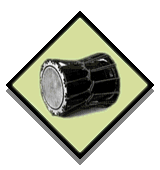
|
The shamisen is the most important instument in Kabuki. Imported to Japan around the same time Kabuki was created, it became the main instrument for all schools of music started in the Edo period. Here Manjiro plays a short passage often used in dances that feature characters of great strength.
|

|
The tsuzumi is the central instrument around which the percussion ensemble is formed. Its distinctive "pon" is a symbol for traditional Japanese culture as a whole
|

|
The Odaiko drum is used to create various sound effects, such as the sound of rain or the wind. The fast beats used here symbolize the appearance of a ghost. Note how the eerie sound of the flute adds to the effect.
|

|
The Okawa side drum has a sharp, distinctive sound that sets it apart from the other drums with softer skins.
|

|
Usually the first sound one hears when one enters the theater is the shime daiko drum, which is used to signal the beginning and end of a performance.
|






